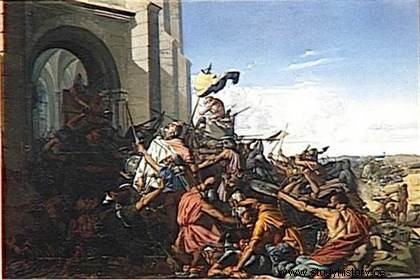 Robert the Strong (820-866), Count of Anjou and Blois and Marquis of Neustria, is considered the ancestor of the Capetians. Established in the Pays de la Loire and Vieille France, he distinguished himself by defending these regions against Norman incursions and carved out a reputation that would be the source of his family's fortune. During one of his rides, he died in 866 in Brissarthe (today in Maine-et-Loire), where he intercepted a band of Normans who were joining their bases after looting Le Mans. His sons would become the future Kings of France Eudes I and Robert I.
Robert the Strong (820-866), Count of Anjou and Blois and Marquis of Neustria, is considered the ancestor of the Capetians. Established in the Pays de la Loire and Vieille France, he distinguished himself by defending these regions against Norman incursions and carved out a reputation that would be the source of his family's fortune. During one of his rides, he died in 866 in Brissarthe (today in Maine-et-Loire), where he intercepted a band of Normans who were joining their bases after looting Le Mans. His sons would become the future Kings of France Eudes I and Robert I.
The family of Robert the Strong
The origin of Robert the Strong remained obscure for a long time. He is very probably the son of Robert III of Hesbaye (died in 834), count of Worms and Oberrheingau, missus imperial in the region of Mainz. This family, from the Rhine and Main valley, is linked to the Carolingians; the most distant ancestors gravitated in the entourage of Charles Martel. It includes Cancor, founder of the Abbey of Lorsch.
His mother is Weltrade, sister of Count Eudes of Orléans, father of Ermentrude, wife of King Charles II the Bald (823, 840, †876). The exact date of birth of Robert the Strong is unknown, but he was probably born between the years 810 and 820, in the last years of the reign of Charlemagne (†814) or the first years of the reign of Louis the Pious (781, †840).
It is related in several ways to the Carolingians:
By his mother, daughter of Eudes d'Orléans, father of Ermentrude, wife of Charles the Bald;
By his grandfather, brother of Ingramm, father of Ermengarde, first wife of Louis the Pious.
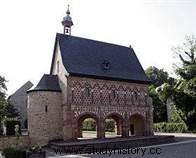 Legend however long lent Saxon ancestry to Robert the Strong. In particular, the chroniclers Aimoin de Fleury, monk of Saint Benoit sur Loire, and Richer, monk of Saint-Rémi de Reims, writing in the 10th and 11th centuries, qualify it as such. His father, a Saxon nobleman named Witichin, is said to have been among the Saxons deported by Charlemagne in the years 794-800.
Legend however long lent Saxon ancestry to Robert the Strong. In particular, the chroniclers Aimoin de Fleury, monk of Saint Benoit sur Loire, and Richer, monk of Saint-Rémi de Reims, writing in the 10th and 11th centuries, qualify it as such. His father, a Saxon nobleman named Witichin, is said to have been among the Saxons deported by Charlemagne in the years 794-800.
He probably married a second time, Adélaïde, mother of Hugh the Abbot, daughter of Hugh of Alsace and widow of Conrad I of Burgundy. He has three children:
- a daughter, Richilde;
- Eudes, Count of Paris, King of West Francia from 888 to 898, born around 860;
- Robert, King of West Francia from 922 to 923, born after 860, great-grandfather of Hugh Capet.
At his death, Robert's honors and offices do not go to his sons Eudes and Robert, who are children. It is to Hugues l'Abbé, his cousin, a priori the half-brother of Eudes, that Charles the Bald transmits them. Belonging to the powerful Welf family, Hugues was notably abbot of Saint-Martin d'Auxerre, adviser to Louis II le Bègue (846, 877, †879) then to his two sons Louis III (863, 879, †882) and Carloman (867, 879, †884).
Robert the Strong, Marquis of Neustria
In August 843, the three surviving sons of Louis the Pious signed the partition treaty known as the "Treaty or Partition of Verdun". This treaty put an end to the struggles between the three brothers that had lasted since the death of their father in 840.
Louis the German (806, †876) receives the eastern part of the Empire, East Francia:Bavaria, the provinces of Alemania and Franconia as well as Saxony;
Charles le Chauve (823, †876) receives the lands west of the Escaut-Meuse-Saône-Rhône line, i.e. West Francia, Aquitaine, Septimania;
Lothaire (795, †855) receives a kingdom sandwiched between the two parts of his brothers, Francia Mediane, which goes from Friesland to Provence including Lotharingia and the 'Italy. He keeps the title of Emperor and his kingdom includes the two capitals of the Empire, the political capital Aix and the religious capital Rome.
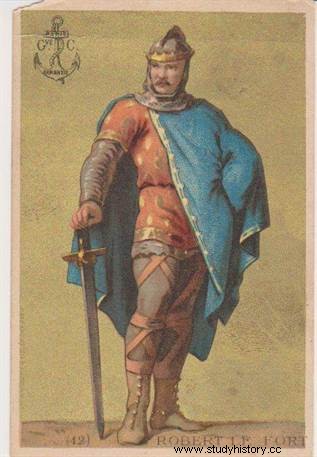 Long negotiations preceded this division, each of the brothers trying to preserve the offices and lands granted to their followers. However, some of them have to drop these charges. Thus, during this period, Robert the Strong left the kingdom of the East held by Louis the Germanic and came to settle in Neustria where he pledged loyalty to Charles the Bald. Robert has several allies in this region, notably from the family of his mother Weltrade, son of Count Eudes of Orléans. It is probably the latter who invites him to join them.
Long negotiations preceded this division, each of the brothers trying to preserve the offices and lands granted to their followers. However, some of them have to drop these charges. Thus, during this period, Robert the Strong left the kingdom of the East held by Louis the Germanic and came to settle in Neustria where he pledged loyalty to Charles the Bald. Robert has several allies in this region, notably from the family of his mother Weltrade, son of Count Eudes of Orléans. It is probably the latter who invites him to join them.
In 852, he appears as "lay abbot of Noirmoutier" in a diploma. In 853, Charles the Bald named him "missus" for Anjou, Maine and Touraine.
The power of Robert the Strong will be forged through the struggles between King Charles the Bald and the Bretons and Vikings. Faithful to this one, several events will however force him to rebel when he will judge his position and his possessions in danger:
In November 845, at Ballon, near Redon, King Charles the Bald faced the Bretons of Duke-King Nominoë (800, †851). He suffered a crushing defeat, narrowly escaped capture and fled into the night, leaving behind his royal insignia. Nominoë sacked Anjou and plundered Angers, but he died suddenly in 851. Charles the Bald resumed the offensive and confronted Erispoé (820, † 857), son and successor of Nominoë. On August 22, in the three-day-long Battle of Juvardel, the Frankish king was again defeated. Again he flees, then decides to deal with the Breton chief:he recognizes his title of king of Brittany, grants him the country of Nantes and Retz as well as the west of Anjou to the Mayenne river. /P>
The Vikings traveled up the Loire, settled on Batailleuse Island and managed in 854 to stay in the city of Angers for a short time.
In 858, Charles the Bald entrusted Maine to his son Louis the Stutterer, whom he planned to marry to Erispoë's daughter.
 The situation of the possessions of Robert the Strong in Anjou was then delicate, threatened both by the Bretons, the Vikings and the arrival of Louis le Bègue. The latter does not take long to provoke the discontent of the great lay people of this region. In 858 they joined forces with the king of Brittany Salomon, successor to Erispoë, chased away Louis le Bègue by forcing him to cross the Seine. Louis the German, called by the insurgents, invades West Francia forcing Charles the Bald to flee.
The situation of the possessions of Robert the Strong in Anjou was then delicate, threatened both by the Bretons, the Vikings and the arrival of Louis le Bègue. The latter does not take long to provoke the discontent of the great lay people of this region. In 858 they joined forces with the king of Brittany Salomon, successor to Erispoë, chased away Louis le Bègue by forcing him to cross the Seine. Louis the German, called by the insurgents, invades West Francia forcing Charles the Bald to flee.
Louis the German's victory was short-lived. In 859, he recrossed the Rhine, leaving his allies in a difficult position. Negotiations begin which last until 860 (peace of Coblentz) and bring forgiveness to all the insurgents and the restitution of all their property except that which they held directly from King Charles. Robert le Fort refuses these conditions which are probably not to his advantage, since he has recently been established in the region. In July 861, following the advice of his relatives, a meeting took place between Charles the Bald and Robert:the reconciliation was sealed and Robert the Strong recovered all of his allegiances and benefits.
From then on, Robert's support for his sovereign was unwavering. He fought the Bretons of Solomon, inflicted two defeats on Louis le Bègue in 862 who, allied with the Bretons, invaded Anjou.
On several occasions, he also defeats Viking troops; thus, in 865, he massacred 500 of them and sent their arms and standards to Charles the Bald. The abbey of Saint-Martin-de-Tours was granted to him as a reward. The following year, he set off, accompanied by the Count of Poitou, in the footsteps of the Viking Hásteinn who ravaged Maine, Anjou, Poitou and Touraine. He surprises them at Brissarthe and dies repelling them.
The Battle of Brissarthe (866)
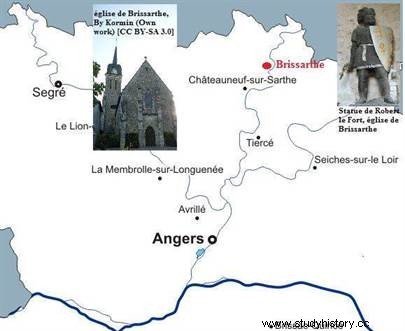 The circumstances of this death are related in the Annals of Saint-Bertin and the chronicle of Réginon de Prüm. :returned to Frankish territory, the Viking chief Hásteinn entered the Loire Valley again in 866, after having scoured the Garonne and the Charente. They attack and loot Le Mans. Robert the Strong gathers his troops and, accompanied by Counts Geoffroy and Hervé of Maine as well as Count Ramnulf of Poitiers, he places himself on the Viking retreat route and intercepts them at Brissarthe.
The circumstances of this death are related in the Annals of Saint-Bertin and the chronicle of Réginon de Prüm. :returned to Frankish territory, the Viking chief Hásteinn entered the Loire Valley again in 866, after having scoured the Garonne and the Charente. They attack and loot Le Mans. Robert the Strong gathers his troops and, accompanied by Counts Geoffroy and Hervé of Maine as well as Count Ramnulf of Poitiers, he places himself on the Viking retreat route and intercepts them at Brissarthe.
There is a ford that allows you to cross the Sarthe. No doubt Robert and his men attacked the Vikings as they were crossing the river. Jostled, they take refuge in the nearby fortified church.
The day is over; It's very hot. Robert le Fort's men are tired from the pursuit. They set up the tents, organize the blockade of the church and, believing the Vikings at their mercy, they relax, take off helmets and breastplates.
Hásteinn then tries everything. He regroups his men and attempts an exit, by surprise. The Franks rush into battle without taking the time to rearm. Robert the Strong falls mortally wounded in front of the door of the church and dies while the Vikings entrench themselves again. Count Ramnulf is shot in the neck with an arrow and dies three days later. Deprived of their leader, the Franks give up the fight.
Throughout the Carolingian world and more particularly for the Rhine and Main families, Robert's death has a deep impact. His bravery is praised; he is compared to Judas Maccabee, hero of the Old Testament. He now becomes Robert the Strong, from the Latin fortis, which means courageous.
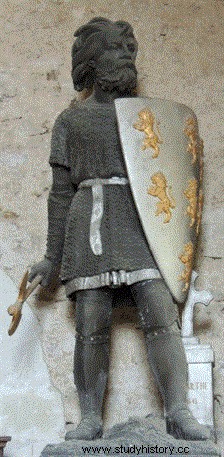 He is buried by his relatives in the church near Seronne, today Chateauneuf-sur-Sarthe .
He is buried by his relatives in the church near Seronne, today Chateauneuf-sur-Sarthe .
Bibliography
- The lords of Châteauneuf-sur-Sarthe in Anjou, Gérard Galand, editions Cheminements, 2005
- Eudes count of Paris and king of France, E. Favre, Champion editions, 1976
- The rise of the Robertian lineage:from the Loire Valley to France, Noizet Hélène, Annuaire-Bulletin de la société de l'histoire de France, 2006, p 19-53
- France before France, 481 – 888, Geneviève Bührer-Thierry, Charles Mériaux, Belin
- The first Robertians and the first Anjou (9th century – 10th century), Karl Ferdinand Werner, in Pays de Loire and Aquitaine from Robert le Fort to the first Capétiens, Society of Western Antiquaries, 1997
- Lot Ferdinand. The Loire, Aquitaine and the Seine from 862 to 866. Robert le Fort. In:Charter School Library. 1915, volume 76. pp. 473-510.
